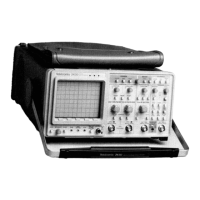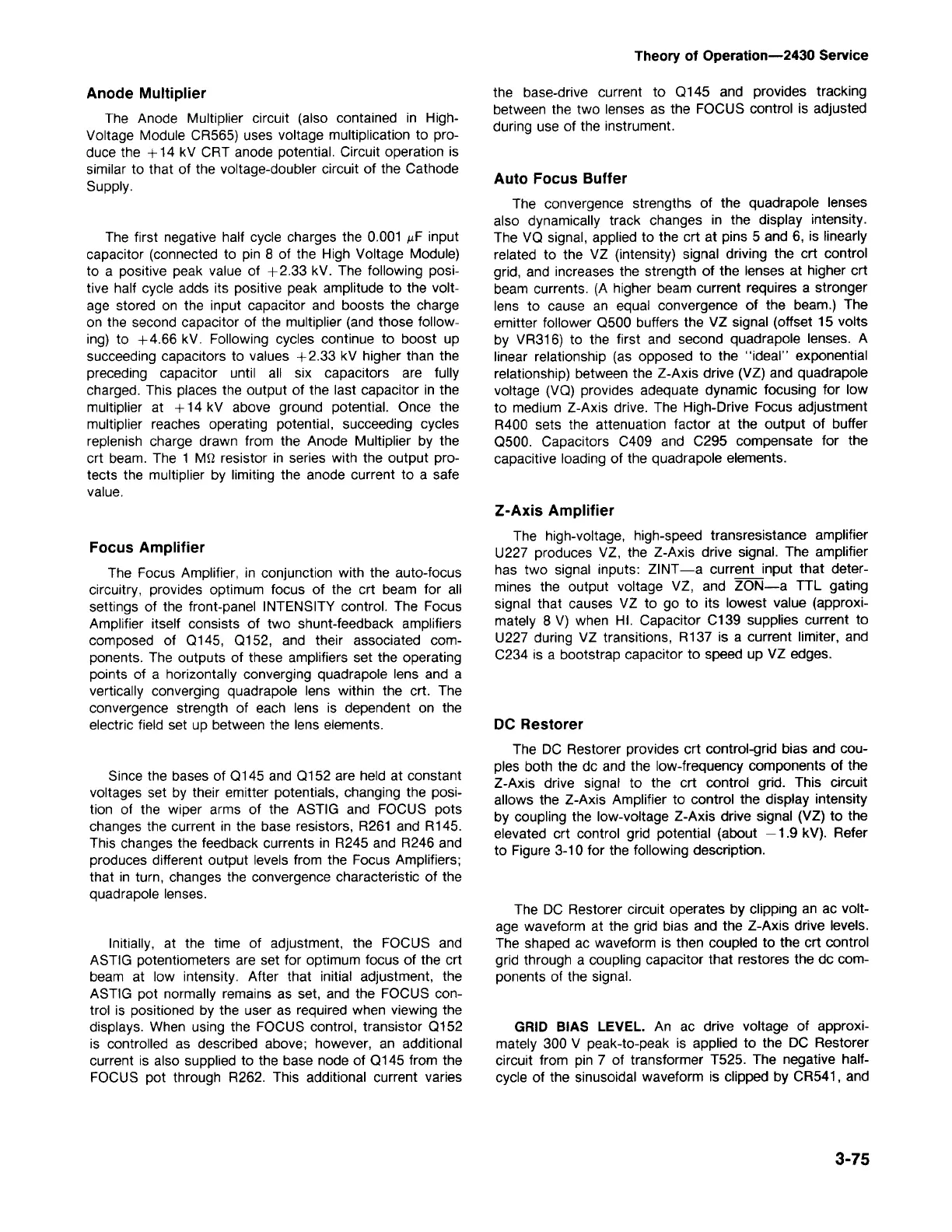3-75
GRID BIAS LEVEL. An ac drive voltage of approxi-
mately 300 V peak-to-peak is applied to the DC Restorer
circuit from pin 7 of transformer T525. The negative half-
cycle of the sinusoidal waveform is clipped by CR541, and
The DC Restorer circuit operates by clipping an ac volt-
age waveform at the grid bias and the Z-Axis drive levels.
The shaped ac waveform is then coupled to the crt control
grid through a coupling capacitor that restores the dc com-
ponents of the signal.
DC Restorer
The DC Restorer provides crt control-grid bias and cou-
ples both the dc and the low-frequency components of the
Z-Axis drive signal to the crt control grid. This circuit
allows the Z-Axis Amplifier to control the display intensity
by coupling the low-voltage Z-Axis drive signal (VZ) to the
elevated crt control grid potential (about -1.9 kV). Refer
to Figure 3-10 for the following description.
Z-Axis Amplifier
The high-voltage, high-speed transresistance amplifier
U227 produces VZ, the Z-Axis drive signal. The amplifier
has two signal inputs: ZINT-a current input that deter-
mines the output voltage VZ, and ZON-a TTL gating
signal that causes VZ to go to its lowest value (approxi-
mately 8 V) when HI. Capacitor C139 supplies current to
U227 during VZ transitions, R137 is a current limiter, and
C234 is a bootstrap capacitor to speed up VZ edges.
Auto Focus Buffer
The convergence strengths of the quadrapole lenses
also dynamically track changes in the display intensity.
The VO signal, applied to the crt at pins 5 and 6, is linearly
related to the VZ (intensity) signal driving the crt control
grid, and increases the strength of the lenses at higher crt
beam currents. (A higher beam current requires a stronger
lens to cause an equal convergence of the beam.) The
emitter follower 0500 buffers the VZ signal (offset 15 volts
by VR316) to the first and second quadrapole lenses. A
linear relationship (as opposed to the "ideal" exponential
relationship) between the Z-Axis drive (VZ) and quadrapole
voltage (VO) provides adequate dynamic focusing for low
to medium Z-Axis drive. The High-Drive Focus adjustment
R400 sets the attenuation factor at the output of buffer
0500. Capacitors C409 and C295 compensate for the
capacitive loading of the quadrapole elements.
the base-drive current to 0145 and provides trackmq
between the two lenses as the FOCUS control is adjusted
during use of the instrument.
Theory of Operation-2430 Service
Initially, at the time of adjustment, the FOCUS and
ASTIG potentiometers are set for optimum focus of the crt
beam at low intensity. After that initial adjustment, the
ASTIG pot normally remains as set, and the FOCUS con-
trol is positioned by the user as required when viewing the
displays. When using the FOCUS control, transistor 0152
is controlled as described above; however, an additional
current is also supplied to the base node of 0145 from the
FOCUS pot through R262. This additional current varies
Since the bases of 0145 and 0152 are held at constant
voltages set by their emitter potentials, changing the posi-
tion of the wiper arms of the ASTIG and FOCUS pots
changes the current in the base resistors, R261 and R145.
This changes the feedback currents in R245 and R246 and
produces different output levels from the Focus Amplifiers;
that in turn, changes the convergence characteristic of the
quadrapole lenses.
Focus Amplifier
The Focus Amplifier, in conjunction with the auto-focus
circuitry, provides optimum focus of the crt beam for all
settings of the front-panel INTENSITY control. The Focus
Amplifier itself consists of two shunt-feedback amplifiers
composed of 0145, 0152, and their associated com-
ponents. The outputs of these amplifiers set the operating
points of a horizontally converging quadrapole lens and a
vertically converging quadrapole lens within the crt. The
convergence strength of each lens is dependent on the
electric field set up between the lens elements.
The first negative half cycle charges the 0.001 IlF input
capacitor (connected to pin 8 of the High Voltage Module)
to a positive peak value of +2.33 kV. The following posi-
tive half cycle adds its positive peak amplitude to the volt-
age stored on the input capacitor and boosts the charge
on the second capacitor of the multiplier (and those follow-
ing) to +4.66 kV. Following cycles continue to boost up
succeeding capacitors to values + 2.33 kV higher than the
preceding capacitor until all six capacitors are fully
charged. This places the output of the last capacitor in the
multiplier at + 14 kV above ground potential. Once the
multiplier reaches operating potential, succeeding cycles
replenish charge drawn from the Anode Multiplier by the
crt beam. The 1 Mil resistor in series with the output pro-
tects the multiplier by limiting the anode current to a safe
value.
Anode Multiplier
The Anode Multiplier circuit (also contained in High-
Voltage Module CR565) uses voltage multiplication to pro-
duce the + 14 kV CRT anode potential. Circuit operation is
similar to that of the voltage-doubler circuit of the Cathode
Supply.

